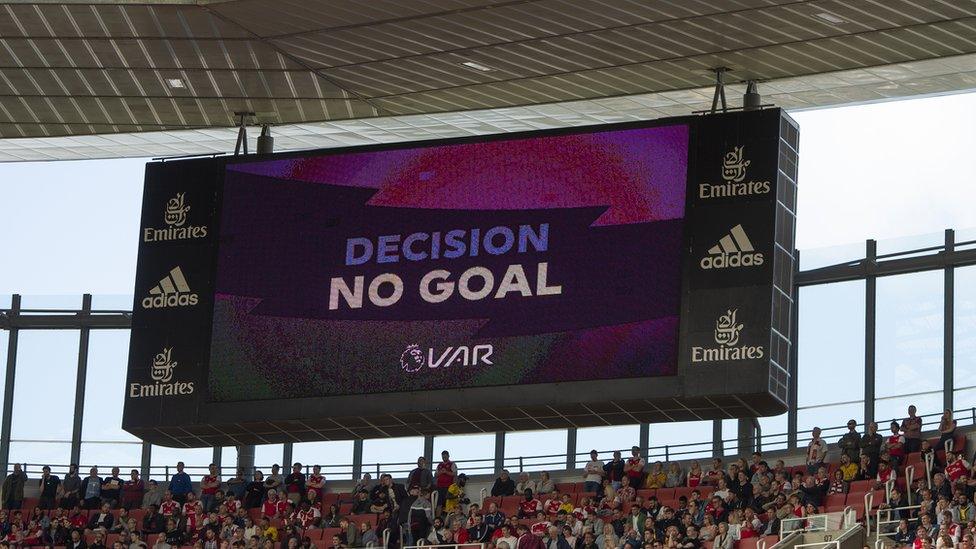VAR in Premier League: How it works
- Published
- comments

We're just two weeks into the new Premier League season and already we've had some VAR controversy.
Manchester City's Gabriel Jesus scored a last-minute winner against Tottenham on Saturday 17 August, only to see it ruled out for an accidental handball following a VAR review.
It means that City have already dropped points in what could prove to be a very close title race this season.
The Video Assistant Referee correctly showed that Aymeric Laporte accidently handled the ball in the build-up to the goal.
Despite the protests of players and fans, rules this season say that a goal can't be scored if the ball is played by a hand, accidently or on purpose. Meaning VAR got the decision right.
So, does VAR need to change, are the rules too strict? Or, do you think it's good for the game that referees are getting help from technology?
What is VAR - and what does it stand for?
The Premier League's Video Assistant Referee system, known as VAR, isn't the first time football has used video technology to try and make correct decisions.
The system was tested in the FA and Carabao Cups in each of the last two seasons, and has already been used in the Italian and German leagues as well as the Women's World Cup and the Men's World Cup in 2018.
How does VAR work?
How does VAR work?
VAR only gets involved when officials have made a 'clear and obvious error' in one of four key areas; goals, penalties, red cards and mistaken identity.
By only getting involved in four types of decisions, it's hoped that VAR won't disrupt the flow of the game.
Goals
A close offside decision is the most common reason for VAR being used after a goal has been scored, but things like shirt-pulling and other fouls could also see goals disallowed after a VAR review.
Under current rules, there is no margin for error for strikers trying to stay in-line with defenders. If a player is offside by a centimetre or even less, the goal will be ruled out, which is exactly what happened when Manchester City scored a third goal against West Ham on the opening weekend.
Penalties
Penalties can be given or taken away using VAR, but only if there has been a 'clear and obvious error' in the original decision.
It can also be used to award retakes if a goalkeeper leaves his or her goal-line. Which is what happened to Scotland in the Women's World Cup.
Straight red cards
In-game straight red cards for violent conduct and dangerous tackles can be given or reversed using VAR.
However, second yellow cards cannot be given with VAR help.
Mistaken identity
If the referee sends-off or books the wrong player, VAR can correct that decision.
Fans will be notified of VAR decisions on stadium screens
How does this work in the game?
The Video Assistant Referees can talk to the on-field referee through an earpiece. If something needs to be looked at the referee will put his hand up to stop play and inform the players that a decision is being reviewed.
VAR reviews the video footage of the incident and advises whether or not action needs to be taken. If there has been an error, the referee will draw a rectangle with their arms - like a big TV screen in the air - to show they're changing their original decision.
At times when decisions are not obvious, the VAR will instruct the referee to watch a replay on a pitch-side screen. This is known as an on-pitch review.
Referees have been told to avoid checking the pitch-side screen whenever possible. These types of review are known to cause long delays.
Where are the video referees?
The video refs are nowhere near the action!
VAR HQ, as it's known, is at Stockley Park in south west London.
Every Premier League manager was invited to visit the HQ during the summer to see how the system works for themselves.
Criticisms
Some fans and football experts aren't happy with VAR so far.
It can take a while to make decisions using the system and that can disrupt the flow of the match. Some games with VAR have ended with five or six minutes of stoppage time.
Spectators also say they're not always aware of when a decision is being reviewed, particularly in grounds like Manchester United's Old Trafford or Liverpool's Anfield which don't have big screens.
In stadiums that don't have screens, there will be a loud speaker announcement.
There are also complaints that the rules are too strict. Goals can be disallowed for the tiniest of margins.
For example, Ruben Neves' stunning goal against Man United was nearly disallowed, after a review for offside in the build-up to his long-range strike. Some fans say those kind of reviews are taking the joy out of the game because nobody can celebrate properly until VAR has done its thing.
Now football has the technology to interpret rules and decisions in high definition or super slow motion, some people think now is also the time to look at the laws of the game.
Should the offside rule be as strict, for example? Especially if goals are being disallowed over a matter of inches, centimetres or even millimetres.
- Published18 August 2019
- Published2 August 2019
